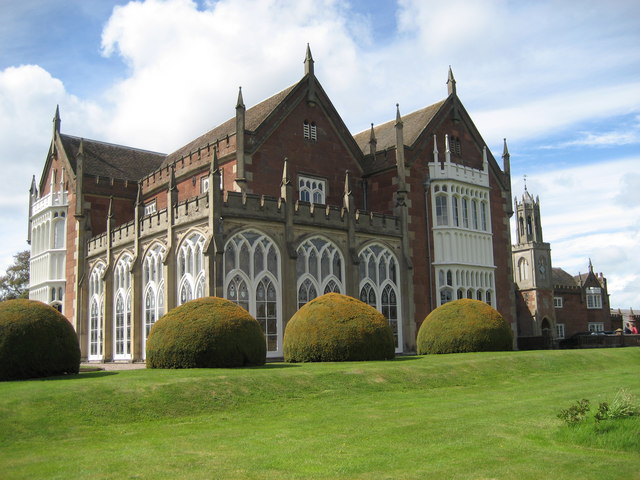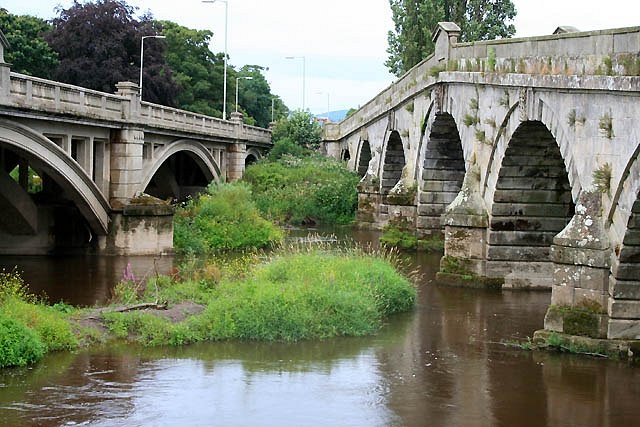|
Longner Hall
Longner Hall is a Grade I listed country house in Longner, Shropshire, England, some 2 miles (3 km) south-east of Shrewsbury in the civil parish of Atcham. It is constructed of red sandstone ashlar in two storeys to an irregular L-shaped floor plan with a plain tile roof and stands in a 170-acre (70 hectare) landscaped park. The grade II listed chest tomb of an Edward Burton, refused burial at the then parish church of St Chad's, Shrewsbury on his death in 1558, sits in the grounds. The hall was built in the Tudor gothic style in 1803 on the site of an earlier house by architect John Nash for Robert Burton, who was High Sheriff of Shropshire for 1804–05. The Burton family had owned the land at Longner since mediaeval times. The gardens were landscaped at the same time by Humphrey Repton. The estate was inherited in 1841 by banker Robert Burton, head of the banking firm of Burton, Lloyd, Salt, How and Co (otherwise known as the Salop Bank) and Mayor of Shrewsbury for a peri ... [...More Info...] [...Related Items...] OR: [Wikipedia] [Google] [Baidu] |
Longnor Hall
Longnor is a village and civil parish off the A49 road, south of Dorrington and north of Leebotwood in Shropshire, England, with a population of 289. The nearest railway station is Church Stretton, 4.7 miles (7.6 km) away. The Cound Brook flows just west of the village and its medieval deer park. The village contains Longnor Hall and the Grade I listed medieval St Mary's Church. Regional Cycle Route 32/33 passes through, as do buses between Church Stretton and Shrewsbury and Radbrook Green. The village is also noted for a ghost, the White Lady of Longnor. Facilities Church St. Mary's Church is a Grade 1 Listed Building in the medieval Early English style. It has been continually and carefully conserved down the centuries. Two new stained glass windows were installed in 2000, to mark the turn of the millennium. Originally a chapel for Condover, it became a private chapel for the Corbett family of Longnor Hall, before taking on the function of a parish church. Longnor ... [...More Info...] [...Related Items...] OR: [Wikipedia] [Google] [Baidu] |
Listed Building
In the United Kingdom, a listed building or listed structure is one that has been placed on one of the four statutory lists maintained by Historic England in England, Historic Environment Scotland in Scotland, in Wales, and the Northern Ireland Environment Agency in Northern Ireland. The term has also been used in the Republic of Ireland, where buildings are protected under the Planning and Development Act 2000. The statutory term in Ireland is "protected structure". A listed building may not be demolished, extended, or altered without special permission from the local planning authority, which typically consults the relevant central government agency, particularly for significant alterations to the more notable listed buildings. In England and Wales, a national amenity society must be notified of any work to a listed building which involves any element of demolition. Exemption from secular listed building control is provided for some buildings in current use for worsh ... [...More Info...] [...Related Items...] OR: [Wikipedia] [Google] [Baidu] |
Shropshire
Shropshire (; alternatively Salop; abbreviated in print only as Shrops; demonym Salopian ) is a landlocked historic county in the West Midlands region of England. It is bordered by Wales to the west and the English counties of Cheshire to the north, Staffordshire to the east, Worcestershire to the southeast, and Herefordshire to the south. A unitary authority of the same name was created in 2009, taking over from the previous county council and five district councils, now governed by Shropshire Council. The borough of Telford and Wrekin has been a separate unitary authority since 1998, but remains part of the ceremonial county. The county's population and economy is centred on five towns: the county town of Shrewsbury, which is culturally and historically important and close to the centre of the county; Telford, which was founded as a new town in the east which was constructed around a number of older towns, most notably Wellington, Dawley and Madeley, which is tod ... [...More Info...] [...Related Items...] OR: [Wikipedia] [Google] [Baidu] |
Atcham
Atcham is a village, ecclesiastical parish and civil parish in Shropshire, England. It lies on the B4380 (once the A5), 5 miles south-east of Shrewsbury. The River Severn flows round the village. To the south is the village of Cross Houses and to the north-west the hamlet of Emstrey. Local governance Atcham once belonged and gave its name to Atcham Rural District, before the village merged into the Borough of Shrewsbury in 1974 and came under Shrewsbury and Atcham Borough Council. From 2009, Shrewsbury and Atcham joined the other districts of non-metropolitan Shropshire under Shropshire Council. The Parliamentary constituency covering the borough remains as Shrewsbury and Atcham. In population, Atcham is the smallest village to be named in a UK Parliamentary constituency. History The village has the only church in England dedicated to Saint Eata, Bishop of Hexham. [...More Info...] [...Related Items...] OR: [Wikipedia] [Google] [Baidu] |
St Chad's Church, Shrewsbury
St Chad's Church occupies a prominent position in Shrewsbury, the county town of Shropshire. The current church building was built in 1792, and with its distinctive round shape and high tower it is a well-known landmark in the town. It faces The Quarry area of parkland, which slopes down to the River Severn. The church is a Grade I listed building. The motto of the church is "open doors, open hearts, and open minds". This indicates the aspiration of the church to be a welcoming church, involved in the community, and on a collective journey seeking after God. Charles Darwin was baptised in St Chad's church in 1809, and as a young boy attended the church with his mother Susannah. In 2010, the church became a member of the Greater Churches Group. History The present building replaced an earlier church, dedicated to St Chad, situated near College Hill; this was a 13th-century building which was largely destroyed when the central tower collapsed in 1788. All that remains of the ... [...More Info...] [...Related Items...] OR: [Wikipedia] [Google] [Baidu] |
John Nash (architect)
John Nash (18 January 1752 – 13 May 1835) was one of the foremost British architects of the Georgian and Regency eras, during which he was responsible for the design, in the neoclassical and picturesque styles, of many important areas of London. His designs were financed by the Prince Regent and by the era's most successful property developer, James Burton. Nash also collaborated extensively with Burton's son, Decimus Burton. Nash's best-known solo designs are the Royal Pavilion, Brighton; Marble Arch; and Buckingham Palace. His best-known collaboration with James Burton is Regent Street and his best-known collaborations with Decimus Burton are Regent's Park and its terraces and Carlton House Terrace. The majority of his buildings, including those that the Burtons did not contribute to, were built by James Burton's company. Background and early career Nash was born in 1752, probably in Lambeth, south London. His father was a millwright also called John (1714–1 ... [...More Info...] [...Related Items...] OR: [Wikipedia] [Google] [Baidu] |
High Sheriff Of Shropshire
This is a list of sheriffs and high sheriffs of Shropshire The sheriff is the oldest secular office under the Crown. Formerly the high sheriff was the principal law enforcement officer in the county but over the centuries most of the responsibilities associated with the post have been transferred elsewhere or are now defunct so that its functions are now largely ceremonial. From 1204 to 1344 the Sheriff of Staffordshire served also as the Sheriff of Shropshire. Under the provisions of the Local Government Act 1972, on 1 April 1974 the office previously known as sheriff was retitled high sheriff. The high sheriff changes every March. Sheriff 11th century * Warin the Bald *c. 1086 Rainald De Balliol, De Knightley (1040–1086) *1102 Hugh (son of Warin) 12th century *-1114: Alan fitz Flaad (died 1114) *1127–1137: Pain fitzJohn (died 1137) *1137–1138: William Fitz Alan (exiled 1138) *1155–1159: William Fitz Alan (died 1160) *1160–1165: Guy le Strange *1166–1169: Ge ... [...More Info...] [...Related Items...] OR: [Wikipedia] [Google] [Baidu] |
Humphrey Repton
Humphry Repton (21 April 1752 – 24 March 1818) was the last great English landscape designer of the eighteenth century, often regarded as the successor to Capability Brown; he also sowed the seeds of the more intricate and eclectic styles of the 19th century. His first name is often incorrectly rendered "Humphrey". Biography Early life Repton was born in Bury St Edmunds, the son of a collector of excise, John Repton, and Martha (''née'' Fitch). In 1762 his father set up a transport business in Norwich, where Humphry attended Norwich Grammar School. At age twelve he was sent to the Netherlands to learn Dutch and prepare for a career as a merchant. However, Repton was befriended by a wealthy Dutch family and the trip may have done more to stimulate his interest in 'polite' pursuits such as sketching and gardening. Returning to Norwich, Repton was apprenticed to a textile merchant, then, after marriage to Mary Clarke in 1773, set up in the business himself. He was not successf ... [...More Info...] [...Related Items...] OR: [Wikipedia] [Google] [Baidu] |
Edward Haycock, Sr
Edward is an English given name. It is derived from the Anglo-Saxon name ''Ēadweard'', composed of the elements '' ēad'' "wealth, fortune; prosperous" and '' weard'' "guardian, protector”. History The name Edward was very popular in Anglo-Saxon England, but the rule of the Norman and Plantagenet dynasties had effectively ended its use amongst the upper classes. The popularity of the name was revived when Henry III named his firstborn son, the future Edward I, as part of his efforts to promote a cult around Edward the Confessor, for whom Henry had a deep admiration. Variant forms The name has been adopted in the Iberian peninsula since the 15th century, due to Edward, King of Portugal, whose mother was English. The Spanish/Portuguese forms of the name are Eduardo and Duarte. Other variant forms include French Édouard, Italian Edoardo and Odoardo, German, Dutch, Czech and Romanian Eduard and Scandinavian Edvard. Short forms include Ed, Eddy, Eddie, Ted, Teddy and Ned. ... [...More Info...] [...Related Items...] OR: [Wikipedia] [Google] [Baidu] |
Grade I Listed Buildings In Shropshire
Grade most commonly refers to: * Grade (education), a measurement of a student's performance * Grade, the number of the year a student has reached in a given educational stage * Grade (slope), the steepness of a slope Grade or grading may also refer to: Music * Grade (music), a formally assessed level of profiency in a musical instrument * Grade (band), punk rock band * Grades (producer), British electronic dance music producer and DJ Science and technology Biology and medicine * Grading (tumors), a measure of the aggressiveness of a tumor in medicine * The Grading of Recommendations Assessment, Development and Evaluation (GRADE) approach * Evolutionary grade, a paraphyletic group of organisms Geology * Graded bedding, a description of the variation in grain size through a bed in a sedimentary rock * Metamorphic grade, an indicatation of the degree of metamorphism of rocks * Ore grade, a measure that describes the concentration of a valuable natural material in the surroun ... [...More Info...] [...Related Items...] OR: [Wikipedia] [Google] [Baidu] |






